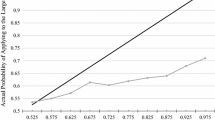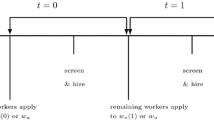Abstract
This paper presents a model of industry dynamics in which worker abilities are complements in production, but frictions permit only gradual sorting among firms. As an industry matures, segregation by skill becomes more marked, the wage distribution widens, and so does the distribution of firm size. Eventually, firms that have ended up with predominantly low-quality workers will exit. The model generates shakeouts with characteristics similar to empirical observation only for intermediate values of entry costs.
Similar content being viewed by others
References
Abowd J.M., Kramarz F. and Margolis D. (1999). High wage workers and high wage firms. Econometrica 67: 251–333
Altonji, J. G., & Devereux, P. J. (1999). The extent and consequences of downward nominal wage rigidity. NBER Working Paper No. 7236.
Becker G.S. (1981). Treatise on the family. Harvard University Press, Cambridge, Mass.
Brixy, U., Kohaut, S., & Schnabel, C. (2005). How fast do newly founded firms mature? Institut für Arbeitsmarkt- und Berufsforschung der Bundesagentur für Arbeit, Discussion paper no. 2/2005.
Brixy U., Kohaut S. and Schnabel C. (2007). Do newly founded firms pay lower wages? First evidence from Germany. Small Business Economics 29: 161–171
Brown C. and Medoff J.L. (2003). Firm age and wages. Journal of Labor Economics 21: 677–697
Cabral L. and Mata J. (2003). On the evolution of the firm size distribution: Facts and theory. American Economic Review 93: 1075–1090
Davis S.J., Haltiwanger J.C. and Schuh S. (1996). Job creation and destruction. MIT Press, Cambridge Mass.
Dunne, T., & Roberts, M. (1990a). Plant, firm, and industry wage variations. Working paper, Department of Economics, Pennsylvania State University.
Dunne, T., & Roberts, M. (1990b). Wages and risk of plant closing. Working paper 6-90-2, Department of Economics, Pennsylvania State University.
Dunne T., Roberts M. and Samuelson L. (1989). The growth and failure of U.S. manufacturing plants. Quarterly Journal of Economics 104: 671–698
French M. (1986). Structural change and competition in the United States tire industry. Business History Review 60: 28–54
Gort M. and Klepper S. (1982). Time paths in the diffusion of product innovations. Economic Journal 92: 630–653
Gschwandtner A. and Lambson V.E. (2002). The effects of sunk costs on entry and exit: Evidence from 36 countries. Economics Letters 77: 109–115
Hall R.E. (1982). The importance of lifetime jobs in the U.S. economy. American Economic Review 72: 716–724
Haltiwanger J.C., Lane J.I. and Spletzer J.R. (2007). Wages, productivity, and the dynamic interaction of businesses and workers. Labour Economics 14: 575–602
Heyman F. (2007). Firm size or firm age? The effect on wages using matched employer-employee data. Labour 21: 237–263
Horvath M., Schivardi F. and Woywode M. (2003). On industry life-cycles: Delay, entry, and shakeout in beer brewing. International Journal of Industrial Organization 19: 1023–1052
Jovanovic B. and MacDonald G.M. (1994). The life cycle of a competitive industry. Journal of Political Economy 102: 322–347
Jovanovic, B., & Tse, C.-Y. (2006). Creative destruction in industries. NBER Working Paper No. 12520.
Klepper S. (1996). Entry, exit, growth and innovation over the product life cycle. American Economic Review 86: 562–583
Korobow A.K. (2002). Entrepreneurial wage dynamics in the knowledge economy. Kluwer Academic Publishers, Dordrecht
Kremer M. (1993). The O-ring theory of economic development. Quarterly Journal of Economics 108: 551–575
Kremer, M., & Maskin, E. (1996). Wage inequality and segregation by skill. NBER Working Paper No. 5718.
Lebow, D. E., Saks, R. E., & Wilson, B. A. (2003). Downward nominal wage rigidity: Evidence from the employment cost index. Advances in Macroeconomics, 3, Article 2. Retrieved August 10, 2008, from http://www.bepress.com/bejm/advances/vol3/iss1/art2.
Lengermann, P., & Vilhuber, L. (2002). Abandoning the sinking ship: The composition of worker flows prior to displacement. (U.S. Census Bureau Technical Paper No. TP-2002-11).
Murphy K. and Welch F. (1992). The structure of wages. Quarterly Journal of Economics 107: 285–326
Springer M.D. and Thompson W.E. (1966). The distribution of products of independent random variables. SIAM Journal on Applied Mathematics 14: 511–526
Storey D.J. (1994). Understanding the small business sector. Routledge, London
Thompson P. (2003). Technological change and the age-earnings profile: Evidence from the international merchant marine, 1861–1912. Review of Economic Dynamics 6: 578–601
Topel R.H. and Ward M.P. (1992). Job mobility and the careers of young men. Quarterly Journal of Economics 107: 439–379
Troske K. (1998). The worker-establishments characteristics database. In: Haltiwanger, J. and Manser, M. (eds) Labor statistics measurement issues, pp 371–404. University of Chicago Press, Chicago
Utterback J. and Suarez F. (1993). Innovation, competition and industry structure. Research Policy 22: 1–21
Wheeler C.H. (2001). Search, sorting and urban agglomeration. Journal of Labor Economics 19: 879–899
Wilson, B. A. (1999). Wage rigidity: A look inside the firm. (Finance and Economics Discussion Series #99–22, Board of Governors of the Federal Reserve System).
Author information
Authors and Affiliations
Corresponding author
Rights and permissions
About this article
Cite this article
Thompson, P., Pintea, M. Sorting, Selection, and Industry Shakeouts. Rev Ind Organ 33, 23–40 (2008). https://doi.org/10.1007/s11151-008-9180-1
Published:
Issue Date:
DOI: https://doi.org/10.1007/s11151-008-9180-1




